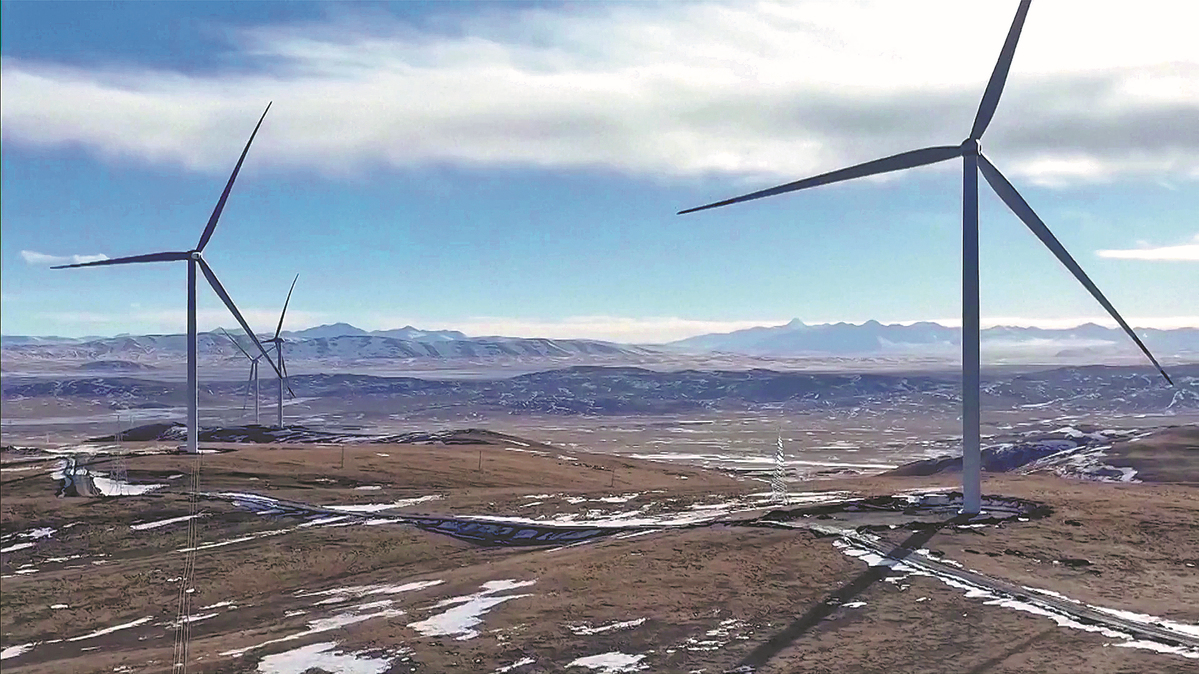Provincial-level regions speed up environmentally friendly power initiative


LHASA — In the past, electricity from Sichuan and Qinghai provinces was transmitted to Southwest China's Xizang autonomous region during power shortages in winter.
Now, the region relies more on its natural resources to get green power.
Last year, the construction of dozens of green power supply projects, such as photovoltaic and wind power, was completed in Xizang.
In early October, 15 wind turbine generators with a single-unit capacity of more than 3 megawatts at Tsomey Drigu wind farm in Shannan were successfully connected to the grid for power generation. Some are 3.6-MW wind turbines, currently the largest single-unit capacity in operation in China's high-altitude areas.
During the peak period of power consumption from this winter to next spring, the region will have 1.39 million kilowatts of photovoltaic power, 100,000 kW of wind power, and 1.12 million kilowatt-hours of energy storage projects connected to the grid together, according to the State Grid Tibet Electric Power Co Ltd.
Mei Fangquan, director of the regional energy administration, said that the region will continue to promote the large-scale transformation of power systems and a high proportion of new energy.
Following the fast development of the clean energy industry, Xizang has drawn many enterprises from East China.
Song Huihua came to Xizang in 2018 and established an energy technology company, which is part of the Unbeatable Group headquartered in East China's Jiangsu province.
The company started a heating device business via the region's abundant solar energy resources, as its capital city, Lhasa, enjoys more than 3,000 hours of sunshine annually. "It is an ideal place to develop solar energy for heating, bringing lower costs for the company," Song said.
So far, the company's products, such as ceramic solar power heaters and the plateau heating bed system, can be found in high-altitude areas across all prefectural-level areas of the region, providing heating for more than 100,000 residents.
"The application of heating technology with clean energy is changing people's lives on the plateau," said Li Xiuwu, head of the regional department of housing and urban-rural development.
In Northwest China's Xinjiang Uygur autonomous region, plentiful power supply from new energy has also attracted some companies of energy-consuming industries to transfer from the eastern areas.
As of Dec 10, Xinjiang had added more than 20.1 million kW of new energy installed capacity last year, and the new grid-connected installed capacity ranked first in the country in 2023, according to the State Grid Xinjiang Electric Power Co Ltd.
Xinjiang's installed power capacity from new energy sources has surpassed 62 million kW. Among them, the installed capacity of wind and photovoltaic power goes beyond 31 million kW and 30.6 million kW, respectively.
Ruihao, a textile company in Xinjiang, which is part of an industrial science and technology group headquartered in Shanghai, built a cotton textile factory in Shache county of Xinjiang's Kashgar prefecture.
"We can combine the advantages of talent and the financial environment in Shanghai and the abundant raw materials and energy in Xinjiang to create opportunities for the enterprise's development," said Zhou Yuanping, general manager of the company.
According to Zhou, the industrial electricity cost in Shache county is between 0.35 yuan (5 US cents) and 0.38 yuan per kWh, about half that in Shanghai.
In Southwest China's Sichuan province, which is rich in hydropower resources, electricity from clean energy is continuously transmitted to Jiangsu, Zhejiang and other places in the Yangtze River Delta region to ensure economic development and meet people's daily demand.
The Baihetan hydropower station, the world's second-largest in total installed capacity, which became fully operational in December 2022, had generated 100 billion kWh of electricity by Oct 12.
Baihetan and five other mega hydropower stations on the Yangtze River form the world's largest clean energy corridor. They are expected to generate 300 billion kWh of electricity annually, reducing coal consumption by over 90 million metric tons and carbon emissions by over 240 million tons.
According to Sichuan's power grid development plan for 2022-25, the province will also accelerate the construction of the integrated renewable energy development base of hydropower, wind power and solar power on the upper reaches of the Yangtze River and promote the development of biomass and geothermal energy in line with local conditions.
The National Energy Administration said last month that China's renewable energy capacity had surpassed thermal power for the first time, constituting more than half of the country's installed power generation capacity. The installed power generation capacity of renewable energy totaled 1.45 billion kW by late 2023.
Xinhua




































